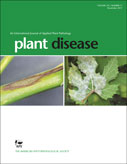Ver ítem
- xmlui.general.dspace_homeCentros e Institutos de InvestigaciónCICVyA. Centro de Investigación en Ciencias Veterinarias y AgronómicasInstituto de BiotecnologíaArtículos científicosxmlui.ArtifactBrowser.ItemViewer.trail
- Inicio
- Centros e Institutos de Investigación
- CICVyA. Centro de Investigación en Ciencias Veterinarias y Agronómicas
- Instituto de Biotecnología
- Artículos científicos
- Ver ítem
Phenotyping sunflower genetic resources for Sclerotinia head rot response: assessing variability for disease resistance breeding
Resumen
Sclerotinia head rot (SHR) is one of the most serious constraints to sunflower (Helianthus annuus L. var. macrocarpus) production worldwide. Here, we evaluated the response to SHR in a sunflower inbred panel from a large INTA germplasm collection, consisting of 137 inbred lines (ILs). Field trials were performed over five consecutive seasons using a twice-replicated randomized complete-block design. Disease incidence, disease severity, incubation period
[ver mas...]
Sclerotinia head rot (SHR) is one of the most serious constraints to sunflower (Helianthus annuus L. var. macrocarpus) production worldwide. Here, we evaluated the response to SHR in a sunflower inbred panel from a large INTA germplasm collection, consisting of 137 inbred lines (ILs). Field trials were performed over five consecutive seasons using a twice-replicated randomized complete-block design. Disease incidence, disease severity, incubation period and area under disease progress curve for disease incidence and severity were determined after controlled inoculation with the pathogen. Statistical analysis using mixed-effect models detected significant differences among ILs for all variables (P<0.001). In addition, Principal Component Analysis (PCA) and distance based methods were used to classify the ILs according to their response to SHR, with ILs ALB2/5261 and 5383 emerging as the most resistant. Broad-sense heritability estimates ranged from 20.64% for disease severity to 10.58% for incubation period. The ample phenotypic variability of our collection, along with the moderate heritability estimates, highlight the importance of molecular breeding approaches to gain new insights into the genetic basis of sunflower resistance to SHR. The exhaustive phenotypic characterization presented here provides a reliable set of variables to comprehensively evaluate the disease and identifies two new sources of resistance to SHR.
[Cerrar]

Fuente
Plant Disease 101 (11) : 1941-1948 (Noviembre 2017)
Fecha
2017-11
Editorial
The American Phytopathological Society
ISSN
1943-7692
Documentos Relacionados
Formato
pdf
Tipo de documento
artículo
Proyectos
(ver más)
INTA/PNBIO/1131042/AR./Genómica aplicada al mejoramiento molecular.
INTA/PNBIO/1131043/AR./Bioinformática y Estadística Genómica.
Palabras Claves
Derechos de acceso
Abierto
 Excepto donde se diga explicitamente, este item se publica bajo la siguiente descripción: Creative Commons Attribution-NonCommercial-ShareAlike 2.5 Unported (CC BY-NC-SA 2.5)
Excepto donde se diga explicitamente, este item se publica bajo la siguiente descripción: Creative Commons Attribution-NonCommercial-ShareAlike 2.5 Unported (CC BY-NC-SA 2.5)


